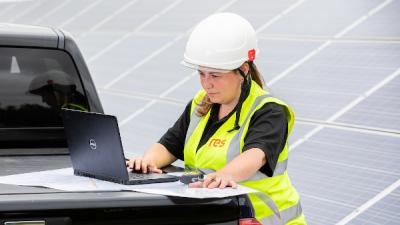Services
Technologies
Promouvoir un avenir énergétique propre grâce à des technologies renouvelables de pointe.
Voir toutes les technologiesRessources
Parcourez nos dernières ressources, notamment les mises à jour de l'entreprise, les témoignages de clients, les informations sur le secteur et les rapports de recherche.
Voir toutes les ressourcesCarrieres
Rejoignez une équipe collaborative de personnes passionnées qui s'engagent dans un travail qui a du sens.
CarrieresÀ propos de RES
Nous vivons notre mission, nous mettons en avant les personnes qui la réalisent et nous célébrons les transformations qui changent la façon dont le monde produit et consomme l'énergie.
Voir à propos de nousEmplacements et bureaux
Tout comme notre entreprise, nous sommes véritablement mondiaux – mais fièrement locaux. Trouvez les coordonnées et l’emplacement de chaque bureau RES.
Nous contacter
With our years of experience of operating both wind and solar assets, we recognised that there were various opportunities for the solar sector to take tips from the more mature wind sector to improve the performance of operational assets.
Knowing that we could increase the availability of solar assets by enhancing traditional O&M strategies and borrowing techniques from the wind sector led our team to pull all of our in-house skills and develop a unique reliability management process.
Whereas most traditional solar O&M strategies focus more on visual inspections, RES’ reliability management service also focuses on diagnostic testing to systematically assess and mitigate risks and compliment the traditional methods.
The process involves undertaking a component-by-component assessment to measure the criticality of its function, Mean Time Between Failure (MTBF), Mean Time To Repair (MTTR) and what its current prevention controls and failure detectability is. This then allows a quantified “Lifetime Failure Risk (LFR)” to be allocated to each piece of equipment, thereby ensuring present risks can be prioritised and mitigated. Mitigation steps typically involve contingency planning for repairs, proactive purchasing of replacement parts, enhanced monitoring and inspection or upgrading of components.
At the end of the Reliability Risk Assessment, owners have a clear picture of the failure risk over the plant lifetime, measured in financial value, and a list of options to reduce the risk including a business case.
This proactive approach to maintenance helps to optimise the allocation of maintenance resources, reduce plant downtime and reduce investment in the wrong spares or in activities that add little value.
RES manages more than 1.3GW of solar across the globe and has implemented this process across the solar assets that we manage, many of which had originally struggled to achieve the budgeted availability. This process has boosted the availability of our solar assets to 99%+.
An example of the introduction of this process is shown in the below chart which shows the improvement of a 50 MW UK solar portfolio.
If implemented industry-wide, this process could unlock millions in savings for investors/owners as well as ensure that solar projects fulfil their potential and help the transition to a future where everyone has access to affordable zero carbon energy.
